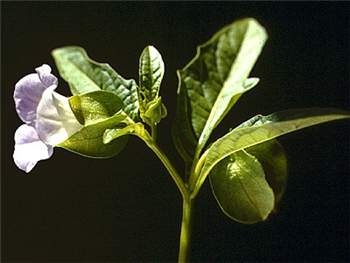Taxonomy
Nicandra Adans., Fam. Pl. 2: 219 (1763) (nom. cons.); after Nicander, a poet of Colophon, who wrote about plants c. 100 BC.
Type species: N. physalodes (L.) Gaertner; Atropa physalodes L.
Summer-growing annual herbs, glabrous, or sparsely pubescent with non-glandular hairs. Leaves alternate, simple, entire or irregularly toothed, petiolate. Flowers solitary, in leaf axils, bisexual, actinomorphic. Calyx 5–lobed; lobes ovate, saggitate at base; persistent in fruit. Corolla broadly campanulate, pale blue to mauve; limb shallowly 5–lobed, the lobes folded in bud. Stamens 5, equal in height, inserted near base of corolla-tube; anthers bilocular, dorsifixed, dehiscing by longitudinal slits. Ovary 3–5–locular. Fruit a dryish berry, enclosed by calyx. Seeds broadly reniform to almost disc-shaped.
A monotypic genus native to Peru, widely cultivated as an ornamental, and naturalised in Australia as a garden escape.
P. Horton, Taxonomic account of Nicandra (Solanaceae) in Australia, J. Adelaide Bot. Gard. 1: 351–356 (1979).
Changes since the Flora of Australia treatment
There have been no changes since the Flora of Australia treatment.
Key to species
A genus, native to Peru, with only a single species, Nicandra physalodes, naturalised in Australia.


